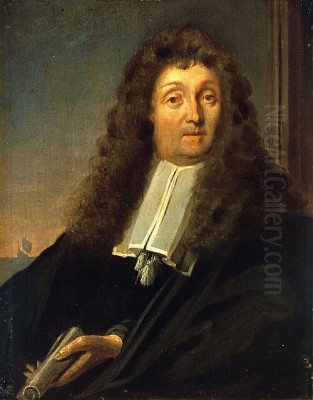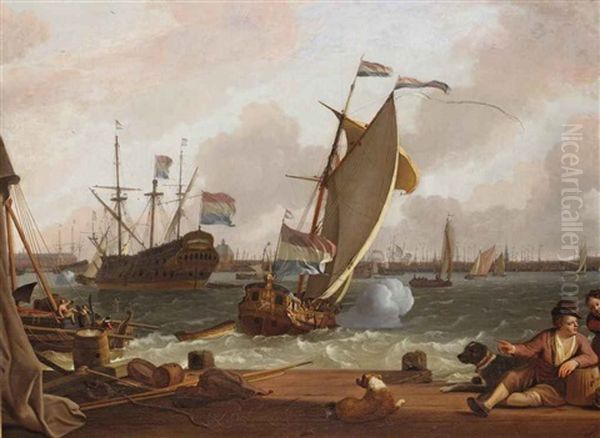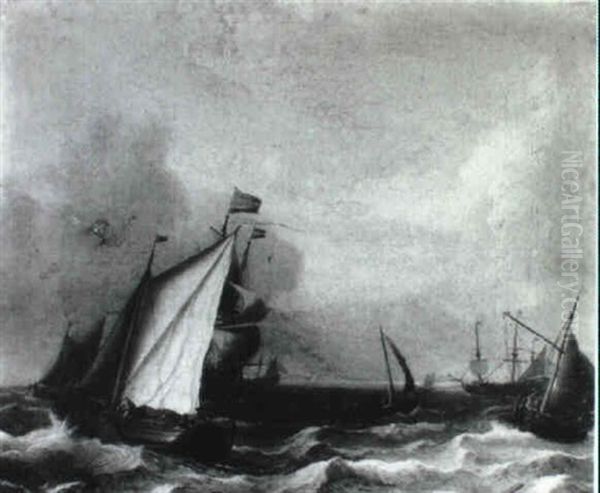
Ludolf Backhuysen the Elder stands as one of the most significant and celebrated marine painters of the Dutch Golden Age. Active during a period when the Dutch Republic dominated global maritime trade and naval power, Backhuysen captured the dynamism, beauty, and peril of the sea with unparalleled skill and dramatic flair. His life, spanning from 1630 to 1708, witnessed the peak and gradual transformation of Dutch maritime supremacy, themes vividly reflected in his extensive body of work. Born in Emden, a port town then belonging to the Netherlands (now Germany), he eventually settled in Amsterdam, the bustling heart of Dutch commerce and culture, where he rose to prominence as the leading seascape artist of his time, particularly after the departure of the renowned Willem van de Velde the Younger and his father to England.
From Clerk to Calligrapher: An Unconventional Path to Art
Backhuysen's journey into the world of professional painting was not a conventional one. He was born in Emden on December 28, 1630. His early career path seemed destined for commerce or administration. He initially worked as a clerk and bookkeeper in a government office in his hometown. Around 1650, seeking greater opportunities, he relocated to Amsterdam, the vibrant metropolis that was then one of the world's most important trading centers.
In Amsterdam, Backhuysen initially found employment with the prominent merchant house of Bartolotti, again utilizing his skills as a clerk and accountant. However, his innate artistic talents soon began to surface. He possessed an exceptionally fine handwriting and gained recognition as a master calligrapher (Kalligraph). This skill was highly valued, not just for practical purposes but also as an art form in itself. He taught calligraphy, reportedly to the sons of wealthy merchants, demonstrating an early engagement with artistic instruction and patronage.

His calligraphic skills naturally led him towards drawing. He began creating intricate pen drawings, often depicting marine subjects like ships and harbour views, executed with remarkable precision. These early works, sometimes referred to as penschilderijen (pen paintings), showcased his meticulous attention to detail and his burgeoning interest in the maritime world that surrounded him in Amsterdam. This initial success as a draughtsman and calligrapher laid the foundation for his eventual transition to oil painting.
Embracing the Sea: The Influence of Masters
Backhuysen's decision to dedicate himself fully to painting occurred in the 1650s. Although largely self-taught in his initial drawing phase, he sought guidance to master the complexities of oil painting. He is known to have studied with or been significantly influenced by several established artists. Arnold Houbraken, the early biographer of Dutch painters, mentions Allart van Everdingen and Hendrick Dubbels as his teachers in oil painting.
Allart van Everdingen, known for his Scandinavian landscapes and seascapes often featuring dramatic rocks and waterfalls, likely imparted a sense of rugged nature and dynamic composition to Backhuysen. Hendrick Dubbels, a slightly older marine painter also active in Amsterdam, specialized in calmer seascapes and winter scenes, often with subtle atmospheric effects. His influence might be seen in Backhuysen's handling of light and water textures, particularly in less turbulent scenes.
Perhaps the most significant, albeit informal, influence came from Willem van de Velde the Elder and his son, Willem van de Velde the Younger. The elder Van de Velde was a master of the grisaille technique – highly detailed monochrome oil paintings or ink drawings on panel or canvas, often depicting naval battles with documentary accuracy. Backhuysen is said to have frequented the Van de Veldes' studio, observing their methods and absorbing their profound knowledge of ship construction and naval affairs. While not a formal pupil, Backhuysen's early pen drawings clearly show the elder Van de Velde's impact, and his later oil paintings engage in a dialogue with the works of both father and son.
Another important figure in the development of Dutch marine painting whose tradition Backhuysen inherited was Simon de Vlieger, a pioneer in depicting atmospheric effects and moving water. Though De Vlieger died in 1653, his innovations paved the way for the next generation, including Backhuysen. The broader tradition of marine specialists like Jan Porcellis and Jan van Goyen, who emphasized tonal harmonies and atmospheric realism, also formed the backdrop against which Backhuysen developed his unique style.
Forging a Dramatic Style: Storms, Ships, and Light

By the early 1660s, Ludolf Backhuysen had established himself as a capable marine painter. He joined the Amsterdam Guild of Saint Luke, the city's official organization for painters and craftsmen, in 1663, cementing his professional status. His reputation grew rapidly, particularly after 1672 when Willem van de Velde the Elder and Younger moved permanently to England to work for King Charles II. This departure left Backhuysen as the undisputed leading marine painter in the Netherlands.
Backhuysen developed a distinctive and highly sought-after style characterized by its dramatic intensity, meticulous detail, and dynamic portrayal of the elements. He became particularly famous for his depictions of rough seas and storm-tossed ships. Unlike the often serene or subtly atmospheric works of some contemporaries like Jan van de Cappelle or the younger Van de Velde's calmer views, Backhuysen frequently chose moments of high drama: ships battling fierce winds and towering waves, often near rocky coastlines, emphasizing the power of nature and the vulnerability of human endeavours.
His ability to render the texture and movement of water was exceptional. He captured the transparency of waves, the foam churned up by wind and ships, and the interplay of light on the water's surface with remarkable verisimilitude. He employed strong contrasts of light and shadow (chiaroscuro) to heighten the drama, often illuminating key elements like a ship's sail or a breaking wave against dark, stormy skies. His colour palette could range from cool greys and blues in stormy scenes to warmer tones in depictions of harbours at sunrise or sunset.
Crucially, Backhuysen combined this dramatic naturalism with an extraordinary accuracy in depicting ships. His background in detailed drawing served him well. He possessed an intimate knowledge of different vessel types, their rigging, and construction. Whether painting Dutch warships, merchantmen, fishing boats (haringbuizen), or elegant yachts (jachten), his portrayals were technically precise, satisfying patrons who were often shipowners, merchants, or naval officers themselves. This combination of accuracy and drama became his hallmark.
Masterworks and Prestigious Patrons
Throughout his long career, Backhuysen produced a large number of paintings, drawings, and etchings. Several works stand out as representative of his style and achievements. Ships in Distress off a Rocky Coast (1667), now in the National Gallery of Art, Washington D.C., is a prime example of his dramatic storm scenes. It showcases his ability to create a terrifyingly convincing image of maritime peril, with ships struggling against a violent sea and looming rocks under a dark, turbulent sky.
Another key work is the View of Amsterdam with Ships on the River IJ (c. 1665-1667), held by the Louvre Museum in Paris. This painting, possibly related to a commission from the Amsterdam burgomaster Louis de Houguené mentioned in early sources, presents a panoramic view of the bustling waterway that was vital to the city's prosperity. It combines topographical accuracy with lively depictions of various ships, including ceremonial yachts, showcasing the city's maritime pride.
His painting The Harbour of Amsterdam (mentioned as commissioned by Houguené) likely refers to similar panoramic views celebrating the city's maritime life. He received commissions not just from local dignitaries but also from international royalty and nobility. His patrons included Cosimo III de' Medici, Grand Duke of Tuscany, King Louis XIV of France (or at least his ministers), Frederick I of Prussia, and Peter the Great of Russia. The Russian Tsar famously visited Backhuysen's studio during his trip to Holland and even took drawing lessons from the aged master.
The Departure of William III and Mary of Orange for England (related to the events of 1688) is another significant work, demonstrating his ability to commemorate historical events with maritime grandeur. A version of this subject achieved a record auction price for the artist in 2006, selling for £1.46 million. His painting Christus in De Storm op Helder van Galilea (Christ in the Storm on the Sea of Galilee), also in the Louvre, shows him applying his marine skills to a biblical narrative, a common practice among Dutch artists. Other notable works include Ships in a Gathering Storm (1658) and numerous depictions of specific naval encounters or ship portraits.
Beyond the Easel: Draughtsman, Etcher, and Gallerist
Ludolf Backhuysen's artistic output was not confined to oil painting. He remained a prolific draughtsman throughout his life, producing numerous sketches and finished drawings in ink and wash. These often served as studies for paintings but were also appreciated as artworks in their own right. His drawings exhibit the same energy and attention to detail found in his paintings, capturing fleeting effects of weather and sea.
He was also an accomplished etcher, creating prints that further disseminated his marine compositions. His etchings often display a freedom and spontaneity that complements the more finished quality of his paintings. Subjects range from tranquil harbour scenes to dramatic shipwrecks, mirroring the themes of his painted oeuvre. An early print is known to be held by the Koninklijke College Zeemanshoop in Amsterdam.
In addition to his creative work, Backhuysen was an astute manager of his career. In his later years, he reportedly ran his own gallery or studio space in Amsterdam where he displayed and sold his works, alongside perhaps those of other artists. This practice was relatively innovative for the time and suggests a keen understanding of the art market. While the description of him as "curator of the art gallery in the Amsterdam Royal Palace" might be an overstatement or misinterpretation based on his connections and status, his operation of a private gallery space is more reliably documented and marks him as a precursor to modern art dealing. His initial profession as a calligrapher also remained part of his identity.
Personal Life and Anecdotes
Backhuysen's personal life appears to have been as eventful as his professional one. He married four times. Little is known about his first two wives. His third marriage, in 1660, was to Alida Greffet, the daughter of a wealthy silk merchant. This union likely improved his financial standing and social connections. After Alida's death, he married Anna de Hooghe in 1680, who ran a silk business herself, further securing his comfortable position. These marriages suggest an integration into the prosperous merchant society of Amsterdam.
Anecdotes passed down, particularly by Arnold Houbraken, paint a picture of a dedicated and somewhat daring artist. Houbraken recounts that Backhuysen's passion for observing the sea in all its moods led him to hire boatmen to take him out onto the turbulent waters of the Zuiderzee (the large inlet bordering Amsterdam) during storms. While the boatmen might have been fearful, Backhuysen would be sketching furiously, capturing the raw power of the elements firsthand. Upon returning, soaked but exhilarated, he would immediately retreat to his studio to translate his fresh observations onto canvas. This story, whether entirely factual or embellished, highlights the commitment to direct observation that underlies the convincing realism of his storm scenes.
His studio became a point of interest for distinguished visitors to Amsterdam, including royalty like Peter the Great, reflecting his high standing both locally and internationally. He maintained his artistic activity well into old age, dying in Amsterdam on November 17, 1708, just shy of his 78th birthday. He was buried in the city's Westerkerk.
Influence and Legacy
Ludolf Backhuysen exerted a considerable influence on marine painting both during his lifetime and after his death. As the leading practitioner in Amsterdam following the departure of the Van de Veldes, his dramatic style became highly fashionable and widely imitated. Several artists are considered his pupils or direct followers. Abraham Storck, another Amsterdam painter known for his detailed views of harbours, ships, and river scenes, worked in a style closely related to Backhuysen's, though often with brighter colours and a focus on festive or ceremonial occasions.
Other artists mentioned as being influenced by him include Jan Claesz Rietschof and his son Hugo van Rietschoten, who specialized in marine subjects, and Michiel Maddersteg (possibly the "Middelstael" mentioned in the source text), who worked as an assistant in Backhuysen's studio for a time. His impact extended beyond direct pupils; his compositions and dramatic approach were emulated by numerous lesser-known marine painters in the late 17th and early 18th centuries.
His influence can also be seen indirectly in the work of artists not exclusively focused on marine subjects but who incorporated seascapes or ships into their work, such as Aert van der Neer, known for his moonlit landscapes and winter scenes which sometimes included frozen waterways with boats. Backhuysen's international fame also meant his work was known and potentially influential abroad, particularly in Germany and England, where marine painting traditions continued to flourish.
Market Presence and Collections Today
Ludolf Backhuysen's works were highly valued during his lifetime and have remained sought after by collectors ever since. His paintings commanded high prices, reflecting his status. The significant price achieved for The Departure of William III at auction in 2006 attests to his continued importance in the art market. His works frequently appear at major auctions of Old Master paintings.
Today, Backhuysen's paintings, drawings, and etchings are held in the collections of major museums around the world. The Rijksmuseum in Amsterdam holds a significant collection, appropriately for the city where he spent most of his career. Other prominent holdings can be found in the Mauritshuis in The Hague, the Louvre in Paris, the National Gallery in London, the Wallace Collection in London, the National Gallery of Art in Washington D.C., the Hermitage Museum in St. Petersburg (likely stemming from Peter the Great's interest), the Royal Museums of Fine Arts of Belgium in Brussels, and numerous important museums in Germany (such as Berlin, Dresden, and his birthplace Emden).
His widespread presence in these institutions ensures that his work is accessible for study and appreciation by scholars and the public. Exhibitions dedicated to Dutch Golden Age painting or marine art invariably feature his contributions prominently. He is recognized not only for his technical brilliance and dramatic compositions but also as a crucial chronicler of the Dutch Republic's relationship with the sea.
Conclusion: The Enduring Power of Backhuysen's Seas
Ludolf Backhuysen the Elder occupies a pivotal position in the history of art. Emerging from a commercial background, he transformed himself into the preeminent marine painter of the Dutch Golden Age in its later phase. His work bridges the meticulous observation of the earlier generation with a heightened sense of drama and dynamism that looked forward to later developments in marine art. His storm scenes remain powerful evocations of nature's force, while his harbour views and ship portraits offer invaluable insights into the maritime culture of the 17th-century Netherlands.
His technical mastery, particularly in rendering water, weather effects, and complex ship rigging, set a standard for marine painting. His influence extended to numerous contemporaries and followers, shaping the course of the genre. Through prestigious commissions and international patronage, his fame spread across Europe. Today, the enduring appeal of his work, found in museums worldwide and commanding respect in the art market, confirms Ludolf Backhuysen's status as a true master of the sea, whose canvases continue to convey the awe-inspiring power and vital importance of the maritime world.